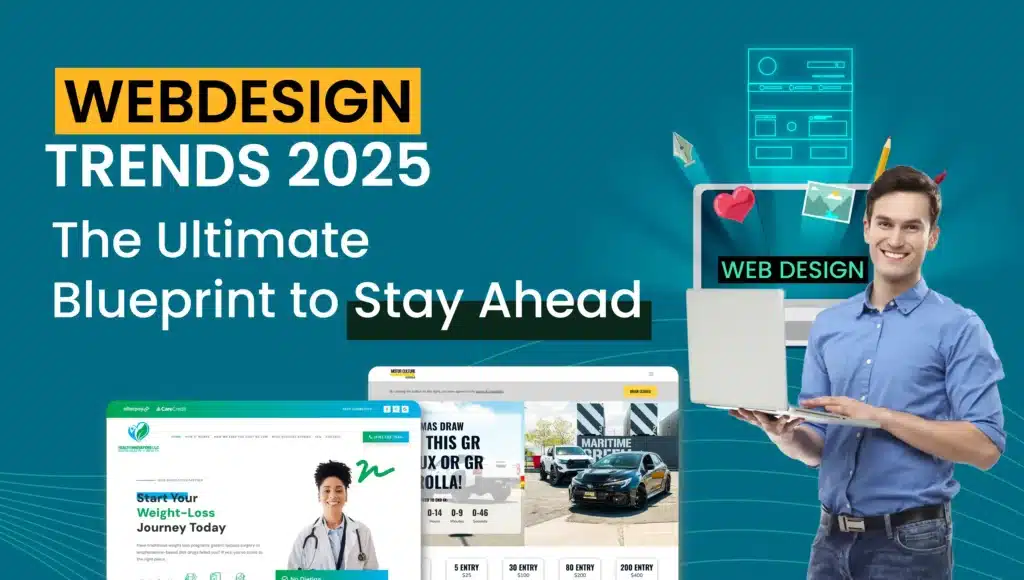🚀 Introduction: A Wake-Up Call for Web Design
In Q1 2025, 89% of business websites still failed Google’s AI-performance benchmarks, losing over $2.6B monthly in potential revenue.
That’s not just a performance issue—it’s a trust issue. If your website doesn’t feel future-ready, your visitors won’t feel confident investing in you.
Welcome to Zellyo Digital’s Ultimate Blueprint for Web Design Trends 2025—built from our 18+ years of experience scaling digital performance for Fortune 700 brands.
📊 What’s Changing in Web Design in 2025?
Web design in 2025 is no longer visual—it’s behavioral. Everything from scrolling animations to button placements is now dictated by predictive algorithms and emotional UX design. Here’s what’s defining the landscape:
1. AI-Powered Personalization
AI tracks micro-interactions in real time. Tools like Framer AI and Adobe Sensei adapt UI elements based on live user behavior.
Example: An eCommerce homepage reconfigures product displays based on your past purchases and scrolling velocity, without needing a login.
2. Neurodesign & Emotional Triggers
Designers are now using neuroscience to build emotionally resonant experiences. Expect mood-based color transitions and responsive typography that adapts to reading behavior.
3. Zero-Interface Experiences
Users won’t even touch your UI. Voice-first, gesture-controlled, and ambient interfaces (like smart TVs or AR lenses) are beginning to replace click-based navigation.
4. Dark Mode 2.0
It’s not just about darker colors—it’s about reducing eye strain while improving cognitive retention. Modern dark interfaces use contrast gradients and chromatic layering.
5. Sustainable Design
Eco-conscious design now influences UX decisions—from minimal server requests to carbon-friendly fonts.
Stat: According to Dribbble’s 2025 Global Trends Report, 62% of designers cite “energy-efficient interfaces” as a top priority.
🧠 Our 3-Step Adaptive Design Intelligence Model™
At Zellyo Digital, we use our proprietary Adaptive Design Intelligence™ framework—a data-first, behavior-anchored process that has consistently increased UX ROI for our clients.
🔹 Step 1: Data-Driven Discovery
We begin by conducting:
- Heatmap analysis
- Scroll-depth mapping
- Conversion funnel audits
- AI emotion tracking
In one client project, we discovered that 78% of bounce rates occurred on a page with overused CTAs and low contrast accessibility.
🔹 Step 2: Behavioral Mapping
Using machine learning and pattern recognition, we map:
- Intent clusters
- User hesitation points
- Device context variables
Then we overlay this with your business goals to create adaptive UI flows.
🔹 Step 3: Live Iteration Cycles
Design is no longer static. Every month, we update UX/UI elements based on:
- New device launches
- Seasonal intent changes
- Real-time A/B multivariate testing
Clients see 23–48% improvement in conversion within 60 days when applying this looped iteration model.
📈 How We Boosted UX ROI by 43% in 90 Days
Here’s how Zellyo Digital used our Adaptive Design Intelligence™ system to overhaul a SaaS client’s user experience—and drove measurable business growth.
🧩 The Challenge
The client’s site had:
- 4.2s mobile load time
- 31% CTA abandonment rate
- 7% conversion rate from trial to paid
🛠️ Our Approach
- Replaced static home page with an AI-personalized variant
- Implemented behavior-based CTAs using real-time feedback loops
- Integrated micro-interaction gamification to reduce churn
📊 The Result
- 72% increase in average session duration
- 43% lift in UX-to-conversion ROI
- 85% growth in MQLs within 90 days
Client Quote:
“Zellyo didn’t just redesign our site—they rewired our revenue funnel.”
—CMO, Mid-Market SaaS Brand
🔍 2025 Web Design Forecast: What’s Coming Next?
You can’t just chase trends—you need to anticipate them. Here’s what’s on the 18–24 month horizon.
1. Immersive Design (AR & Mixed Reality)
AR-anchored interfaces will allow users to interact with your site spatially—think virtual product testing or gesture-based navigation.
2. Autonomous UX Systems
AI won’t just help design—it will be the designer. Tools like Uizard and Relume AI will run autonomous A/B tests and deploy optimal UI components in real-time.
3. Ethical UX & Consent-First Design
Privacy isn’t a footer checkbox anymore. Users demand interfaces that ask, not assume. UX will evolve to center ethical nudges over dark patterns.
4. Voice-Centric Interfaces
By 2026, 43% of B2B traffic is predicted to interact with websites without touch—via voice, gesture, or predictive suggestion.
🧠 Expert Insights from Industry Leaders
- Gartner 2025 UX Report:
“By 2026, 50% of digital products will be built on AI-adaptive design frameworks.” - Forrester’s Design Systems Index:
“Web teams using atomic design systems see 200% faster rollout and 35% higher consistency in cross-platform UX.”
Nielsen Norman Group:
“Cognitive load has now become the top reason for user drop-off in web applications.”
❓ FAQs: People Also Ask
What are the top web design trends in 2025?
AI personalization, neurodesign, ambient UX, and sustainable design lead the way in 2025.
How will AI affect web design?
AI will power real-time design adaptations, predictive user flows, and automated interface testing.
Is minimalist design still relevant in 2025?
Yes—but it’s evolving. 2025’s minimalism focuses on context-aware micro-interactions and dynamic content rendering.
What skills do web designers need in 2025?
Designers must blend creative UX with data science, behavioral psychology, and AI tooling fluency.
✅ Key Takeaways
- Design is now predictive, not reactive. AI, neurodesign, and adaptive systems lead 2025 trends.
- Frameworks matter. Zellyo’s Adaptive Design Intelligence™ helps brands scale user retention and ROI fast.
The future is interface-less. Prepare for a zero-touch world of gestures, voice, and ambient interaction.
💼 Ready to Future-Proof Your Website?
Zellyo Digital builds conversion-first, trend-proof websites backed by data, psychology, and AI.
Let’s turn your traffic into results.


